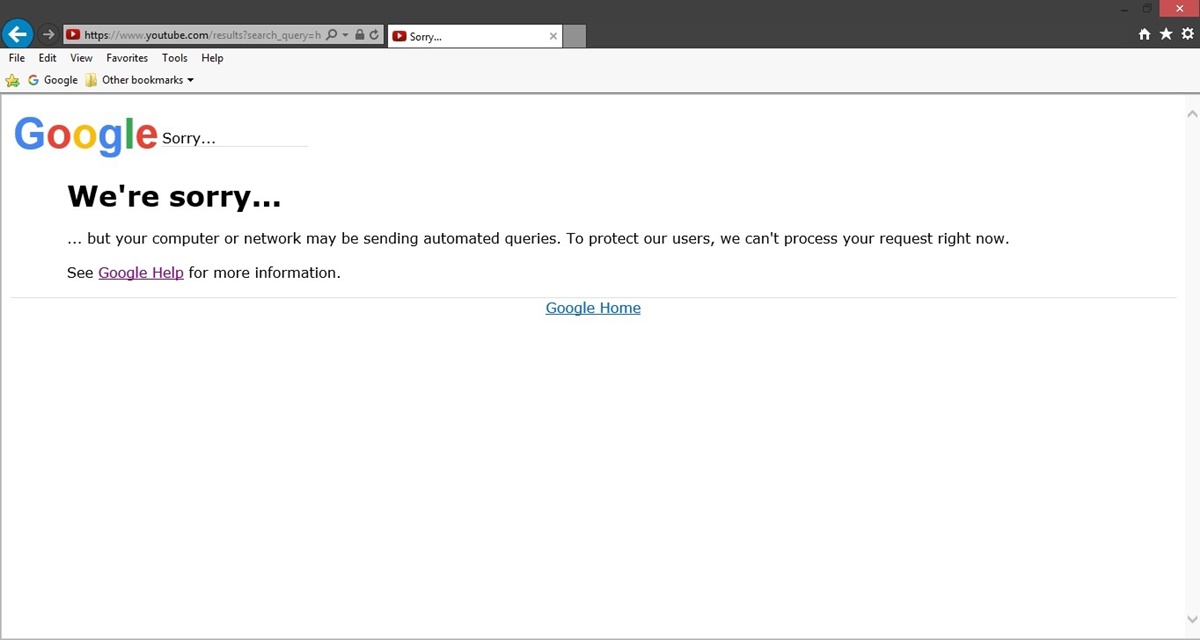What is ‘Unusual Traffic’ in Google Messages?
Google Messages is one of the most popular messaging apps in the world, offering a seamless communication experience for users. However, at times, you may encounter a message that says, “Unusual Traffic Detected” when using Google Messages. But what exactly does this mean?
‘Unusual Traffic’ refers to patterns or behaviors that are deemed abnormal or suspicious by the Google Messages system. When such traffic is detected, Google may temporarily restrict or limit certain features of your account. The aim is to protect users and maintain the integrity and security of the platform.
This could happen if you send a significantly higher volume of messages at a rapid rate, trigger multiple actions within a short period of time, or engage in activities that resemble spam or automated actions. While this restriction is temporary, it can be frustrating if you rely heavily on the app for your messaging needs.
It’s important to note that this restriction is not specific to Google Messages alone. Many online platforms and services employ similar security measures to protect their users from potential spam, abuse, or unauthorized activities.
Now that we have an understanding of what ‘Unusual Traffic’ means, let’s explore how Google Messages detects it.
How does Google Messages detect ‘Unusual Traffic’?
Google Messages utilizes various algorithms and systems to detect and prevent ‘Unusual Traffic’ on its platform. These systems continuously analyze user activity and look for patterns that deviate from normal usage. While Google does not disclose the exact details of its detection methods, there are several factors that can contribute to the identification of ‘Unusual Traffic’.
1. Message Volume: Google Messages monitors the volume of messages sent from an account within a specific timeframe. If a large number of messages are sent in a short period, it can trigger the ‘Unusual Traffic’ detection system.
2. Message Velocity: The speed at which messages are sent can also raise red flags. Sending a high volume of messages at an accelerated rate may be indicative of spamming or automated behavior.
3. Account Activity: Google Messages takes into account the overall activity of an account. If an account suddenly increases its activity levels significantly or engages in suspicious behavior, it can trigger the ‘Unusual Traffic’ detection system.
4. Behavior Analysis: The system analyzes user behavior to identify any unusual patterns. This can include actions such as repeatedly sending the same message, constantly switching between conversations, or rapidly scrolling through messages.
5. IP Address Analysis: Google Messages may also analyze the IP address from which the messages are being sent. If multiple accounts are using the same IP address and exhibiting suspicious activity, it can indicate potential abuse or spamming.
It’s important to note that while Google Messages has robust detection systems in place, false alarms can occasionally occur, leading to legitimate users being flagged as exhibiting ‘Unusual Traffic’. If you believe your account has been wrongly restricted, you can reach out to Google Support for assistance.
Now that we understand how Google Messages detects ‘Unusual Traffic’, let’s explore the reasons behind its detection.
Why does Google Messages detect ‘Unusual Traffic’?
Google Messages detects ‘Unusual Traffic’ for several important reasons. The primary goal is to ensure the safety and security of its users and the platform as a whole. By detecting and addressing suspicious behavior, Google can prevent spam, abuse, and potential security threats.
Here are some key reasons why Google Messages detects ‘Unusual Traffic’:
1. Protection against Spammers: ‘Unusual Traffic’ detection helps to identify and block spammers who attempt to flood users with unsolicited messages. By limiting the activity of accounts showing abnormal behavior, Google can prevent spam from reaching users’ inboxes and maintain a positive user experience.
2. Mitigation of Automated Actions: ‘Unusual Traffic’ detection is crucial in detecting and preventing automated actions carried out by bots or scripts. These actions often aim to exploit the system or manipulate messaging features for malicious purposes. By restricting accounts engaging in such activities, Google ensures that the platform is used for legitimate communication.
3. Security of User Data: Google Messages safeguards user data, including conversations and other personal information. The ‘Unusual Traffic’ detection system helps identify any suspicious activity that may compromise user data or privacy. By taking action against accounts showing abnormal behavior, Google minimizes the risk of data breaches and unauthorized access.
4. Maintaining Platform Integrity: Google Messages aims to provide a reliable and trustworthy messaging service. By monitoring for ‘Unusual Traffic’, Google can maintain the integrity of the platform and protect it from potential misuse. This helps create a more secure and enjoyable experience for all users.
While the ‘Unusual Traffic’ detection system may sometimes inconvenience legitimate users, it plays a crucial role in maintaining a secure and spam-free environment within Google Messages. By promptly addressing suspicious behavior, Google ensures that users can communicate safely and with confidence.
Now that we understand why Google Messages detects ‘Unusual Traffic’, let’s explore how to resolve this issue.
How to fix ‘Unusual Traffic’ issue in Google Messages?
If you encounter the ‘Unusual Traffic’ issue in Google Messages, there are several steps you can take to resolve it. Follow these guidelines to restore normal functionality to your account:
1. Slow Down: If you have been sending messages at a rapid pace, take a break and reduce the volume and velocity of your messages. Sending messages in a more natural and spaced-out manner can help avoid triggering the ‘Unusual Traffic’ detection.
2. Verify Account Security: Ensure that your Google account has not been compromised. Check for any suspicious activity, unauthorized access, or unexpected changes in your account settings. If necessary, change your password and enable two-factor authentication to enhance the security of your account.
3. Review Connected Apps and Extensions: If you have granted access to third-party apps or browser extensions that interact with Google Messages, review the permissions and remove any that you no longer need. This reduces the chances of unusual or unintended actions triggering the detection system.
4. Update the App: Make sure you are using the latest version of the Google Messages app. Developers regularly release updates that may include bug fixes or improvements to the ‘Unusual Traffic’ detection system.
5. Clear App Data and Cache: Sometimes, clearing the app data and cache can help resolve temporary issues. Go to your device’s settings, find the Google Messages app, and clear its data and cache. This will reset the app and remove any potential conflicts or corruption.
6. Contact Google Support: If the issue persists or you believe that your account has been wrongly restricted, reach out to Google Support for assistance. They can review your account activity and take necessary steps to address the ‘Unusual Traffic’ issue.
Remember, the ‘Unusual Traffic’ detection is in place to protect users and ensure overall platform security. By following these steps, you can address the issue and restore normal functionality to your Google Messages account.
Now that we have discussed how to fix the ‘Unusual Traffic’ issue, let’s explore some tips to avoid triggering the detection system in the future.
Tips for avoiding ‘Unusual Traffic’ detection in Google Messages
If you want to avoid triggering the ‘Unusual Traffic’ detection system in Google Messages, here are some helpful tips to keep in mind:
1. Pace your Messages: Avoid sending a large number of messages in a short period. Space out your messages and send them at a more natural and reasonable pace. This will help prevent your account from being flagged as exhibiting unusual activity.
2. Be Mindful of Automated Actions: Google Messages may interpret excessive and rapid actions as automated behavior. Avoid using any scripts or bots that send messages automatically, as this can trigger the ‘Unusual Traffic’ detection system. Stick to manual actions to ensure a more authentic and natural user experience.
3. Avoid Constant Message Sending: While it may be tempting to engage in back-to-back messaging, try to avoid constantly sending messages to the same recipient. This kind of behavior can be seen as spamming and may trigger the ‘Unusual Traffic’ detection. Take breaks between messages to maintain a steady and more balanced communication pattern.
4. Utilize Multiple Messaging Platforms: Instead of relying solely on Google Messages, consider diversifying your messaging platforms. This allows you to distribute your messaging activity across different apps and reduce the risk of triggering the ‘Unusual Traffic’ detection on a single platform.
5. Limit Bulk Actions: Be cautious when performing bulk actions such as deleting or archiving multiple conversations at once. Such actions can be seen as abnormal behavior, especially if done in quick succession. Instead, manage your conversations in smaller batches to avoid raising any red flags.
6. Avoid Excessive Message Editing: Making frequent and extensive edits to your messages can be seen as suspicious activity. Try to compose your messages thoughtfully and avoid making numerous edits once you have sent them. This reduces the chances of your account being flagged for ‘Unusual Traffic’.
By following these tips, you can minimize the risk of triggering the ‘Unusual Traffic’ detection system in Google Messages. Remember that the goal is to maintain a natural and authentic user experience while ensuring the safety and security of the platform.
Now, let’s address some commonly asked questions about ‘Unusual Traffic’ in Google Messages.
Frequently Asked Questions about ‘Unusual Traffic’ in Google Messages
1. What happens when my account is flagged for ‘Unusual Traffic’ in Google Messages?
When your account is flagged for ‘Unusual Traffic’, Google may temporarily restrict certain features, such as sending messages, to protect users and the platform. Once the suspicious activity is resolved and detected, the restrictions are lifted, and normal functionality is restored.
2. Can I appeal or report a false ‘Unusual Traffic’ detection in Google Messages?
Yes, if you believe your account has been wrongly flagged or restricted, you can reach out to Google Support for assistance. They will review your account activity and take appropriate actions to address the issue.
3. Does ‘Unusual Traffic’ detection affect receiving messages?
In most cases, the ‘Unusual Traffic’ detection primarily impacts the sending functionality of your Google Messages account. However, depending on the severity of the suspicious activity, there may be delays or limitations in receiving messages as well.
4. How long does it take for the ‘Unusual Traffic’ restrictions to be lifted?
The duration of ‘Unusual Traffic’ restrictions can vary. In some cases, it may be lifted within a few hours, while in others, it may take a couple of days. Google’s systems analyze the account activity and automatically remove the restrictions once the suspicious behavior subsides.
5. How can I prevent my Google Messages account from being flagged for ‘Unusual Traffic’?
To minimize the risk of being flagged for ‘Unusual Traffic’, pace your messages, avoid automated actions, and maintain a balanced and natural communication pattern. Additionally, follow the tips mentioned earlier in this article to avoid triggering the detection system.
6. Can using third-party messaging apps trigger ‘Unusual Traffic’ detection?
While Google Messages may detect ‘Unusual Traffic’ from third-party messaging apps, it primarily focuses on the activity within the Google Messages app itself. However, it’s essential to review the permissions and security measures of any third-party apps you use to ensure they don’t engage in suspicious behavior.
Remember, the ‘Unusual Traffic’ detection system in Google Messages exists to protect users and maintain the security and integrity of the platform. If you have any concerns or questions, it’s best to reach out to Google Support for assistance.
With this information in mind, you should now have a clearer understanding of ‘Unusual Traffic’ in Google Messages.


